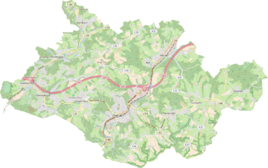Oberauel (Overath)
|
Oberauel
City of Overath
Coordinates: 50 ° 57 ′ 15 ″ N , 7 ° 13 ′ 22 ″ E
|
||
|---|---|---|
| Height : | 96 m above sea level NHN | |
|
Location of Oberauel in Overath |
||
|
Houses in Oberauel
|
||
Oberauel is a district of Untereschbach in the town of Overath in the Rheinisch-Bergisches Kreis in North Rhine-Westphalia , Germany .
Location and description
The Oberauel residential area is located on the border with Bergisch Gladbach above the nearby Sülz on Landesstraße 284, which is called Oberauel here . Nearby is the nature-protected clay pit Oberauel , an abandoned quarry. In the area with wet green areas and hillside forests, rare animals and plants have found their home. Places in the near are Untersteeg , Schmitzbüchel , Heidgen and Löhe .
history
The name Auel is derived from * ouwala , * ouwila , whose root word ouwa (= waterland ) is to be understood in the sense of a river meadow surrounded by water on several sides.
According to old writings, the Oberauel farm (also called The Great Auelerhof ) once comprised several hundred acres of land. In 1564 it is mentioned for the first time in connection with the feudal association of the Meer monastery . Thereafter, in 1570, the monastery pledged the farm to a creditor who did not redeem the pledge, after which all rights were transferred to the house of Nesselrode-Ehreshoven . In 1862 the estate was sold to the Cologne merchants FW Paas and Heinrich Neuland and divided up.
The Topographia Ducatus Montani by Erich Philipp Ploennies , Blatt Amt Steinbach , shows that the living space had a courtyard in 1715, which is labeled as Auel and designated as Freihof. Carl Friedrich von Wiebeking names the court on his charter of the Duchy of Berg in 1789 as Auel . It emerges from it that the local area was part of the Unterirchspiel Immekeppel in the upper court of Bensberg at that time .
The place is recorded on the topographical survey of the Rhineland from 1817 as if. Aul . The Prussian first recording from 1845 shows the residential area under the name Auelter Hof . From the Prussian new admission of 1892, the place is regularly recorded on measuring table sheets as Ober-Auel or Oberauel .
In 1822 13 people lived in the (Ober-) Auel categorized as a farm estate , which after the collapse of the Napoleonic administration and its replacement belonged to the mayor's office of Bensberg in the Mülheim am Rhein district . For the year 1830 16 inhabitants are given for the place called Ober-Auel . The place, which was categorized as a building property in 1845 according to the overview of the government district of Cologne , had a residential building with 9 inhabitants at that time, all of whom were Catholic. The municipality and estate district statistics of the Rhine Province lists Oberauel in 1871 with ten houses and 75 inhabitants. In the municipality lexicon for the Rhineland province of 1888, 15 houses with 117 inhabitants are given for Ober Auel . In 1895 the place had ten houses with 90 inhabitants and was part of the Catholic parish Immekeppel. In 1905 twelve houses and 113 inhabitants are given.
On the basis of Section 10 of the Cologne Act , several Bensberg outlying areas were transferred to the Overath community in 1975, including the area around Untereschbach with Oberauel.
See also
Tongrube Oberauel nature reserve
Individual evidence
- ↑ "Tongrube Oberauel" nature reserve in the specialist information system of the State Office for Nature, Environment and Consumer Protection in North Rhine-Westphalia , accessed on August 17, 2017.
- ^ Heinrich Dittmaier : settlement names and settlement history of the Bergisches Land . In: Journal of the Bergisches Geschichtsverein . tape 74 , parallel edition as a publication by the Institute for Historical Regional Studies of the Rhineland at the University of Bonn. Schmidt, Neustadt ad Aisch 1956.
- ↑ Jörg Poettgen (editor): 950 years Overath (1064 - 2014) / street names tell Geshcihte , publisher Bergischer Geschichtsverein Overath 2014, pp. 38/39
- ^ Wilhelm Fabricius : Explanations for the Historical Atlas of the Rhine Province ; Second volume: The map of 1789. Division and development of the territories from 1600 to 1794 ; Bonn; 1898
- ↑ Alexander A. Mützell: New topographical-statistical-geographical dictionary of the Prussian state . tape 1 . Karl August Künnel, Halle 1821.
- ↑ Friedrich von Restorff : Topographical-statistical description of the Royal Prussian Rhine Province , Nicolai, Berlin and Stettin 1830
- ↑ Overview of the components and list of all the localities and individually named properties of the government district of Cologne: by districts, mayor's offices and parishes, with information on the number of people and the residential buildings, as well as the Confessions, Jurisdictions, Military and former state conditions. / ed. from the Royal Government of Cologne [Cologne], [1845]
- ↑ Royal Statistical Bureau Prussia (ed.): The communities and manor districts of the Prussian state and their population . The Rhine Province, No. XI . Berlin 1874.
- ↑ Königliches Statistisches Bureau (Prussia) (Ed.): Community encyclopedia for the Rhineland Province, based on the materials of the census of December 1, 1885 and other official sources, (Community encyclopedia for the Kingdom of Prussia, Volume XII), Berlin 1888.
- ↑ Königliches Statistisches Bureau (Prussia) (Ed.): Community encyclopedia for the Rhineland Province, based on the materials of the census of December 1, 1895 and other official sources, (Community encyclopedia for the Kingdom of Prussia, Volume XII), Berlin 1897.
- ↑ Royal Statistical Bureau (Prussia) (Ed.): Community encyclopedia for the Rhineland Province, based on the materials of the census of December 1, 1905 and other official sources, (Community encyclopedia for the Kingdom of Prussia, Volume XII), Berlin 1909
- ^ The Cologne Act in full. Retrieved June 7, 2016 .


